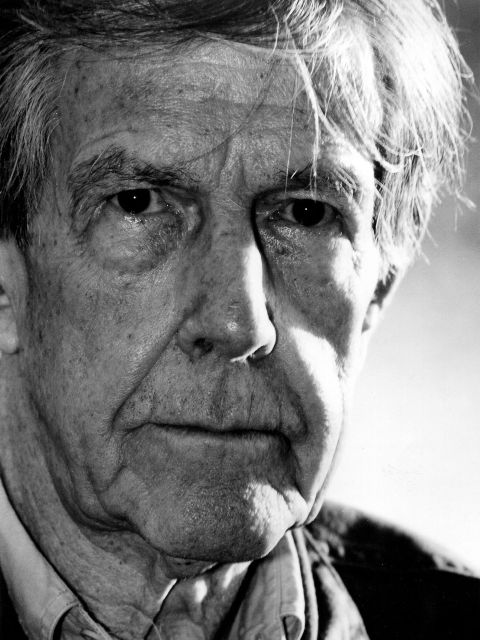


Even after his death, John Cage remains a controversial figure. Famously challenging the very notion of what music is, Cage remained on the leading edge of both playful and profound experimentalism for the greater part of his career, collaborating with and influencing generations of composers, writers, dancers, and visual artists. One of his best-known and most sonically intriguing innovations, the prepared piano, had become an almost commonplace compositional resource by the end of the twentieth century. Years before the invention of the synthesizer, he was in the forefront in the exploration of electric and electronic sound sources, using oscillators, turntables, and amplification to musical ends. He pioneered the use of graphic notation and, in employing chance operations to determine musical parameters, was the leading light for one cadre of the avant-garde that included Morton Feldman, Christian Wolff, Earle Brown, and Pauline Oliveros. Cage produced works of "performance art" years before the term was coined, and his 4'33'' (1952) -- in which the performers are instructed to remain silent for four minutes and thirty-three seconds -- takes a place among the most notorious touchstones of twentieth century music.
Cage was born on September 5, 1912, in Los Angeles, California. After boyhood piano lessons, he pursued both formal and informal musical studies that ranged from classes at Pomona College to cultural excursions throughout Europe to lessons with American composer Adolph Weiss.
Cage's true mentors were Henry Cowell and Arnold Schoenberg, two very different musical personalities. Cage's music from the 1930s and 1940s demonstrates the direct influence of both Schoenberg and Cowell, and is marked especially by the use of percussion instruments and the prepared piano. While Cage's early music was based, like Schoenberg's, primarily on the organization of pitch, rhythmic structures became increasingly important, no doubt due in part to the composer's associations with the world of dance. He had worked as a dance accompanist at UCLA and then took a similar position at the Cornish School of the Arts in Seattle, Washington, in 1938. Here he met, and developed a working relationship, with choreographer/dancer Merce Cunningham.
The most important aesthetic development in Cage's career came as a result of his studies of Eastern philosophies, especially Zen Buddhism, in the late 1940s and throughout the 1950s. The result was music derived, at least in part, from quasi-random decisions determined by the I Ching (the Chinese Book of Changes). Instead of imposing an inviolable order upon the conventional elements of Western music, Cage endeavored "to make a musical composition[,] the continuity of which is free of individual taste and memory (psychology) and also of the literature and 'traditions' of the art." The embodiment of this philosophy is well illustrated by Cage's Imaginary Landscape No. 4 (1951). The score calls for the prescribed manipulations of knobs on twelve radios; the aural result is dependent on what happens to be on the airwaves at the instant of performance. In "composing" works in such a fashion, Cage ensured that each realization of the score would provide a unique sonic experience.
Cage's ecumenically experimental spirit continued to thrive into the 1960s and beyond. The "environmental extravaganza" Musicircus (1967) incorporates everything from rock music to pantomime to film; HPSCHD (1967) mixes computer technology with the music of Mozart, Beethoven, and Chopin. Child of Tree (1975) calls for the amplification of a potted plant, Inlets (1977) for four conch shells and the sound of fire, and Il Treno (1978) for "prepared trains."
Though his career unfolded largely without the confines of the musical establishment in America, Cage became something of a beloved elder statesman of music in his later years, honored with formal distinctions and concerts marking his major birthdays. He died in New York City on August 12, 1992.
Biography by Michael Rodman Source: allmusic
Watch and listen the videos: Thirteen Harmonies,
Dream, Imaginary Landscapes, 4'33", Seven2, Ocean
of Sounds, Water Walk, Six Melodies, Fifty-Eight, In a
Landscape, playing amplified cacti and plant with a
feather, Chance Conversations, A Book of Music,
Sonata II for Prepared Piano, Amores, Sonata V, Solo
for Sliding Trombone, Sonatas and Interludes, Bird
Cage, Litany for the Whale, Five, I Have Nothing to
Say and I am Saying It, Bacchanale, Fontana Mix,
Music of Changes, Musik Im Technischen, Tossed as
it is Untroubled, Third Construction, Atlas Eclipticalis,
Sonatas para piano preparado (15 videos), Four,
Variations, Nocturne for Violin and Piano, Branches,
Dream, First Interlude, Roaratorio, In the name of
Holocaust, Popular videos John Cage and Merce
Cunningham (45 videos), Popular videos (109 videos)
and Top Tracks (332 videos).
Dream, Imaginary Landscapes, 4'33", Seven2, Ocean
of Sounds, Water Walk, Six Melodies, Fifty-Eight, In a
Landscape, playing amplified cacti and plant with a
feather, Chance Conversations, A Book of Music,
Sonata II for Prepared Piano, Amores, Sonata V, Solo
for Sliding Trombone, Sonatas and Interludes, Bird
Cage, Litany for the Whale, Five, I Have Nothing to
Say and I am Saying It, Bacchanale, Fontana Mix,
Music of Changes, Musik Im Technischen, Tossed as
it is Untroubled, Third Construction, Atlas Eclipticalis,
Sonatas para piano preparado (15 videos), Four,
Variations, Nocturne for Violin and Piano, Branches,
Dream, First Interlude, Roaratorio, In the name of
Holocaust, Popular videos John Cage and Merce
Cunningham (45 videos), Popular videos (109 videos)
and Top Tracks (332 videos).
Nenhum comentário:
Postar um comentário